![]()
![]()
![]()
Use LEFT and RIGHT arrow keys to navigate between flashcards;
Use UP and DOWN arrow keys to flip the card;
H to show hint;
A reads text to speech;
48 Cards in this Set
- Front
- Back
- 3rd side (hint)
|
classification of hormones |
amino acid-based steroids prostaglandins |
|
|
|
Hormones included in amino acid based hormones |
proteins peptides amines |
|
|
|
Hormone from cholesterol |
steroid |
|
|
|
hormone from lipids, acts as local hormone |
prostaglandin |
|
|
|
2 mechanisms of hormones |
direct gene activation second messenger system |
|
|
|
this mechanism is used by steroid hormones and thyroid hormones |
direct gene activation |
|
|
|
this mechanism is used by protein and peptide hormones |
second messenger system |
|
|
|
1. Steroid hormones diffuse through the plasma membrane of target cells 2. Once inside the cell, the hormone enters the nucleus 3. Then, the hormone binds to a specific protein within the nucleus 4. Hormone-receptor complex binds to specific sites on the cell’s DNA 5. Certain genes are activated to transcribe messenger RNA 6. New proteins are synthesized |
direct gene activation |
|
|
|
1. Hormone (first messenger) binds to a membrane receptor2. Activated receptor sets off a series of reactions that activates an enzyme3. Enzyme catalyzes a reaction that produces a second-messenger molecule (such as cyclic AMP, known as cAMP)4. Oversees additional intracellular changes to promote a specific response in the target cell |
second messenger system |
mechanism |
|
|
Hormone levels in the blood are maintained mostly by |
negative feedback |
|
|
|
The stimuli that activate endocrine glands fall into three major categories |
1. Hormonal 2. Humoral 3. Neural |
|
|
|
Most common category of stimulus Endocrine organs are activated by other hormones Example: Hormones of the hypothalamus stimulate the anterior pituitary to secrete its hormones |
hormonal stimuli |
|
|
|
Changing blood levels of certain ions and nutrients stimulate hormone release Humoral indicates various body fluids, such as blood and bile Examples: Parathyroid hormone and calcitonin are produced in response to changing levels of blood calcium levels Insulin is produced in response to changing levels of blood glucose levels |
humoral stimuli |
|
|
|
Nerve fibers stimulate hormone release Most are under the control of the sympathetic nervous system Examples: Sympathetic stimulation of the adrenal medulla to release epinephrine and norepinephrine |
neural stimuli |
|
|

|
pineal gland |
|
|
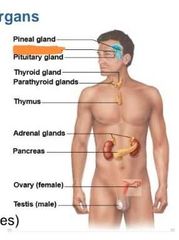
|
Hypothalamus |
|
|
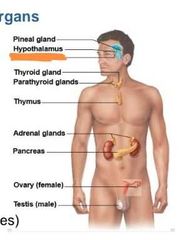
|
Pituitary gland |
|
|
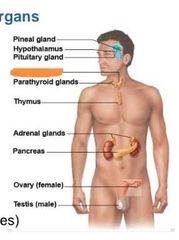
|
thyroid gland |
|
|
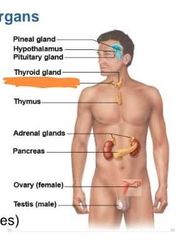
|
Parathyroid gland |
|
|
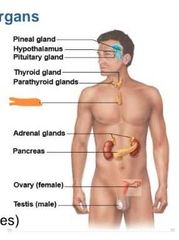
|
thymus |
|
|
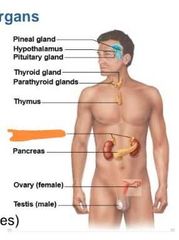
|
adrenal gland |
|
|
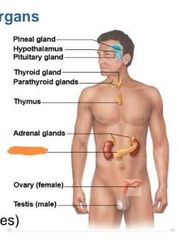
|
pancreas |
|
|
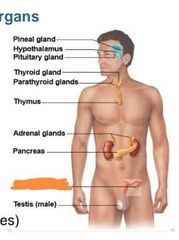
|
ovary |
|
|
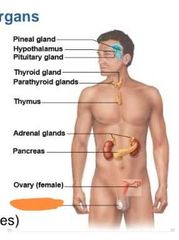
|
testis |
|
|
|
Glands with purely endocrine function |
Anterior pituitary, thyroid, adrenals, parathyroids |
|
|
|
Endocrine glands are _____ glands |
ductless |
|
|
|
mixed glands |
pancreas, gonads |
|
|
|
2 functional lobes of pituitary gland |
Anterior pituitary—glandular tissue Posterior pituitary—nervous tissue |
|
|
|
Pea-sized gland that hangs by a stalk from the hypothalamus in the brain; master endocrine gland |
pituitary gland |
|
|
|
what connects the hypothalamus to the pituitary gland |
portal circulation of hormones |
|
|
|
2 hormones by the hypothalamus |
oxytocin, antidiuretic hormone |
|
|
|
hormones regulated by the hypothalamic / Pituitary system |
Thyroid hormones T4, T3 Cortisol Estrogen or testosterone Insulin like growth factor-I (IGF-I) |
|
|
|
Two hormones affect nonendocrine targets 1. Growth hormone 2. Prolactin Four are tropic hormones 1. Follicle-stimulating hormone 2. Luteinizing hormone 3. Thyrotropic hormone 4. Adrenocorticotropic hormone |
Six anterior pituitary hormones |
|
|
|
results from hyposecretion of GH during childhood |
Pituitary dwarfism |
|
|
|
results from hypersecretion of GH during childhood |
Gigantism |
|
|
|
results from hypersecretion of GH during adulthood |
Acromegaly |
|
|
|
oxytocin, antidiuretic hormone (adh) |
Posterior Pituitary (Hypothalamus) |
|
|
|
Hangs from the roof of the third ventricle of the brain Secretes melatonin Believed to trigger the body’s sleep/wake cycle Believed to coordinate the hormones of fertility in humans and to inhibit the reproductive system until maturity occurs |
Pineal gland |
|
|
|
Found at the base of the throat, inferior to the Adam’s apple Consists of two lobes and a connecting isthmus Follicles are hollow structures that store colloidal material Produces two hormones 1. Thyroid hormone 2. Calcitonin |
Thyroid gland |
|
|
|
Tiny masses on the posterior of the thyroid Secrete parathyroid hormone (PTH) Most important regulator of calcium ion (Ca2+) homeostasis of the blood Stimulates osteoclasts to remove calcium from bone Hypercalcemic hormone (increases blood calcium levels) Stimulates the kidneys and intestine to absorb more calcium |
parathyroid glands |
|
|
|
Located in the upper thorax, posterior to the sternum Largest in infants and children Decreases in size throughout adulthood Produces a hormone called thymosin Matures some types of white blood cells Important in developing the immune system |
Thymus |
|
|
|
Sit on top of the kidneys Two regions 1. Adrenal cortex—outer glandular region has three layers that produce corticosteroids Mineralocorticoids are secreted by outermost layer Glucocorticoids are secreted by middle layer Sex hormones are secreted by innermost layer 2. Adrenal medulla—inner neural tissue region |
adrenal glands |
|
|
|
Mineralocorticoids, Glucocorticoids, Sex hormones |
hormones of the adrenal cortex of the adrenal glands |
|
|
|
epinephrine, norepinephrine |
hormones of adrenal medulla of adrenal glands |
|
|
|
Located in the abdomen, close to stomach Mixed gland, with both endocrine and exocrine functions |
Pancreas |
|
|
|
produce hormones Insulin—produced by beta cells Glucagon—produced by alpha cells These hormones are antagonists that maintain blood sugar homeostasis |
The pancreatic islets (islets of Langerhans) |
|
|
|
ovaries, testis, Estrogen, progesterone |
gonads |
|
|
|
Stomach Small intestine Kidneys Heart |
other hormone producing tissues |
|

